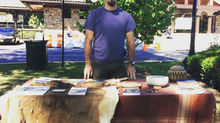Honoring Native American Heritage Month
- Eric Stone

- Nov 20
- 4 min read
November is Native American Heritage Month! The original occupants of the Lower Hudson Valley are of the Munsee Lenape and Wappinger Tribes. The Rewilding School recognizes that much of our modern society is built on the stolen land of Turtle Island, and we intend to lift up Indigenous voices and practices respectfully by sharing some educational resources with you all on our blog post.
November is Native American Heritage Month, and the day after Thanksgiving is Native American Heritage Day. Therefore, we should recognize that the original occupants of the Lower Hudson Valley are of the Munsee Lenape and the Wappinger Tribes, and that most of our modern society is built on stolen land. The continent that we call "North America" is referred to as "Turtle Island" by Indigenous Peoples. To see how Indigenous land overlaps with your home, visit https://native-land.ca/ with a Teacher's Guide to this map.
The Munsee Lenape are a band of Lenni Lenape Peoples (now part of the Delaware Nation) with 3 clans: Munsee is wolf clan, Unami is turtle clan, Unalachtigo is turkey clan. The Munsee are the only remaining clan in existence today. Their traditional language is huluníixsuwaakan.
The Wappinger people are now part of the Mohican and Munsee Tribes; they were historically a looser collection of communities who were also closely related to the Munsee Lenape. Their traditional language is a part of the Eastern Algonquian language group.
You can reach out to the First Nations People in your area to learn how you may become an ally. The Lenape Center is right in New York City! Cultural Preservation events hosted by the Delaware Nation are sometimes open to the broader community. And right here in Chappaqua, NY we have sacred land of ecological importance in Buttonhook Forest that Brothertown Indian Nation and Friends of Buttonhook are working hard to preserve for generations to come.
The Rewilding School respectfully shares these resources in an effort to lift up Indigenous voices and practices. Here you can read the Haudenosaunee Thanksgiving Address, The History of Thanksgiving from the Native American Perspective, and our website’s land acknowledgement.
We are so grateful to teach, learn, and grow with our neighbors on beautiful land in every season. It is an honor to meet compassionate community members like you who encourage us to do what the Rewilding School does best; nourish our wild roots. We wish you a season of gratitude, abundance, and support.
Thank you. Sincerely,
The Rewilding School Team
Below are resources collected previously by Eric Stone and Jessie Moscarello
“We will explore the traditional methods of parenting, cooking, games, survival, dance, song, ceremonies, courtship, marriage, death and burial.”
Evelyn Kionute - Cultural Events Coordinator
Contact: ekionute@delawarenation-nsn.gov
Scientists
Robin Wall Kimmerer
Bio: author of Braiding Sweetgrass and Gathering Moss, SUNY Distinguished Teaching Professor of Environmental and Forest Biology at SUNY ESF
Ways to connect: many wonderful recorded talks on Youtube and elsewhere
Contact: 315-470-6785 | 315-470-6760, rkimmer@esf.edu, https://www.esf.edu/faculty/kimmerer/
Dr. Kat Milligan-Myhre
Bio: Inupiaq, Affiliate Professor at the Department of Biological Sciences, “interested in host-microbe interactions”
Ways to connect: her incredible thread on #IndigenousPeople’sDay,
Contact: kat.mm@alaska.edu, @Napaaqtuk on Twitter
Kylle Roy
Bio: Geneticist with USGS, “Lover of beetles, plants, & answering scientific questions using genetic tools”
Ways to connect: regularly posts accessible and engaging science content on Twitter
Contact: USGS webpage
NDNScienceShow - “A podcast about the intersection of science & Native America” (small following, but on Dr. Milligan-Myhre’s Twitter list)
Indigenous-led conservation
Conserving the boreal forests in Canada https://twitter.com/Borealconserve
Supporting Indigenous Guardians across Canada: https://twitter.com/land_guardians
K-12 Education
Recommended by Dr. Milligan-Myhre for Thanksgiving https://medium.com/age-of-awareness/decolonizing-thanksgiving-a-toolkit-for-combatting-racism-in-schools-5d4e3023a2f8
The Smithsonian’s Native Knowledge 360° Education Initiative https://americanindian.si.edu/nk360/
Outdoor Education
Native Like Water: Native American Education, Conservation and Outreach in California
Geneviève Reynolds
Bio: grad student at University of Victoria's School of Environmental Studies, researching the ecology of historic First Nations village sites, “passionate about outdoor education, trying to get kids (especially girls) connected with nature and science!”
Ways to connect: active and popular Twitter account
Outdoor Rec
Traditional skills
@SiksikaOutdoors on Twitter - “I have Siksika (Blackfoot) roots which, lends to me the love of the First Nations People, the Great Outdoors, Motherearth, Flora-Fauna, Wildlife and Bushcraft”
General news and awareness
Cultural literacy
What is Indigenous cultural safety? (a very useful article for definitions of terms and a broader look at the ways in which Indigenous people are marginalized)
How the language of colonists, even in conservation, leads to violence (A Twitter discussion between scientists providing some food for thought)
What to look for in an Indigenous awareness training program (good parameters even though the website is partially self-promoting)
This checklist makes it easy to stay respectful when educating children on Native Americans https://www.understandingprejudice.org/teach/native.htm























Comments